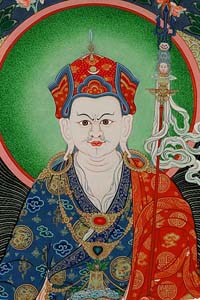
Text
Meanings
1) The Common
Hidden meaning according to:
2) The path of liberation
3) The perfection stage
4) Nyingthig of Dzogpa Chenpo
5) The accomplishment of the result
 |
||||||||||||||
|
1) The Common Meaning / Commentary Introduction This is the level of practicing The Vajra Seven-Line Prayer in relation to the way of Guru Rinpoche’s appearance in this earthly world as a manifested form (Skt. Nirmāṇakāya). In actuality, Guru Rinpoche is not separate from Samantabhadra (Universally Excellent), who is fully liberated from the beginning as the self-arisen Dharmakāya (the ultimate state). Without moving from the sphere of the Dharmakāya, he is spontaneously accomplished in the Sambhogakāya (the enjoyment body in pure forms), which has five absolute qualities.1 He is also the self-arising manifestation in various displays of Nirmāṇakāya (the manifested body in impure forms), the self-reflection of compassion. This is the actual way in which Guru Rinpoche dwells and appears. It is the display of the Buddhas, and they alone can perceive all aspects of his display. Eight (or twelve) years after the mahāparinirvāṇa of Śākyamuni Buddha, Guru Rinpoche appeared on a lotus in Dhanakośa lake of Oḍḍiyāṇa for the ordinary beings of this world who have good karma. He followed different esoteric disciplines and accomplished various attainments, such as the light body of great transformation (’ja’ lus ’pho ba chen po). He served devotees of India, Oḍḍiyāṇa, and Tibet through multiple manifestation, such as the eight forms of the Guru (guru mtshan brgyad). This level of interpretation is the way that we, the common disciples, pray to Guru Rinpoche, an extraordinary object of devotion. The Utterance of the Seed Syllable The prayer begins with the invocation of the enlightened mind of Guru Rinpoche by the utterance of the syllable HŪṂ , the self-arisen seed syllable of the mind of all the Buddhas. The Objects of the Prayer
The Prayer
The Mantra for Invoking Blessing GURU means master or spiritual guide, one who is prosperous with excellent qualities; to whom no one is superior. PADMA is the first part of Guru Rinpoche’s name. SIDDHI is what we want to accomplish—the common and uncommon attainments. HŪṂ means the supplication to bestow the siddhi:s (attainments).
So, o guru padma, bestow the siddhi.
1The absolute certainties of place, teacher, disciple, teaching, and time. 2dang ba’i dad pa: faith that cleanses the mind. ’dod pa’i dad pa: faith that inspires the devotee to accomplish the same attainment as the object of his or her faith. yid ches kyi dad pa: faith that produces full confidence in the object of the faith. |